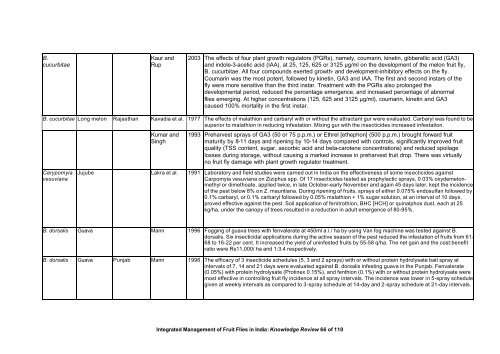“Key Informant Survey” of Production, Value, Losses and ... - DfID
“Key Informant Survey” of Production, Value, Losses and ... - DfID
“Key Informant Survey” of Production, Value, Losses and ... - DfID
Create successful ePaper yourself
Turn your PDF publications into a flip-book with our unique Google optimized e-Paper software.
B.<br />
cucurbitae<br />
Kaur <strong>and</strong><br />
Rup<br />
2003 The effects <strong>of</strong> four plant growth regulators (PGRs), namely, coumarin, kinetin, gibberellic acid (GA3)<br />
<strong>and</strong> indole-3-acetic acid (IAA), at 25, 125, 625 or 3125 µg/ml on the development <strong>of</strong> the melon fruit fly,<br />
B. cucurbitae. All four compounds exerted growth- <strong>and</strong> development-inhibitory effects on the fly.<br />
Coumarin was the most potent, followed by kinetin, GA3 <strong>and</strong> IAA. The first <strong>and</strong> second instars <strong>of</strong> the<br />
fly were more sensitive than the third instar. Treatment with the PGRs also prolonged the<br />
developmental period, reduced the percentage emergence, <strong>and</strong> increased percentage <strong>of</strong> abnormal<br />
flies emerging. At higher concentrations (125, 625 <strong>and</strong> 3125 µg/ml), coumarin, kinetin <strong>and</strong> GA3<br />
caused 100% mortality in the first instar.<br />
B. cucurbitae Long melon Rajasthan Kavadia et al. 1977 The effects <strong>of</strong> malathion <strong>and</strong> carbaryl with or without the attractant gur were evaluated. Carbaryl was found to be<br />
superior to malathion in reducing infestation. Mixing gur with the insecticides increased infestation.<br />
Carypomyia<br />
vesuviana<br />
Kumar <strong>and</strong><br />
Singh<br />
1993 Preharvest sprays <strong>of</strong> GA3 (50 or 75 p.p.m.) or Ethrel [ethephon] (500 p.p.m.) brought forward fruit<br />
maturity by 8-11 days <strong>and</strong> ripening by 10-14 days compared with controls, significantly improved fruit<br />
quality (TSS content, sugar, ascorbic acid <strong>and</strong> beta-carotene concentrations) <strong>and</strong> reduced spoilage<br />
losses during storage, without causing a marked increase in preharvest fruit drop. There was virtually<br />
no fruit fly damage with plant growth regulator treatment.<br />
Jujube Lakra et al. 1991 Laboratory <strong>and</strong> field studies were carried out in India on the effectiveness <strong>of</strong> some insecticides against<br />
Carpomyia vesuviana on Ziziphus spp. Of 17 insecticides tested as prophylactic sprays, 0.03% oxydemetonmethyl<br />
or dimethoate, applied twice, in late October-early November <strong>and</strong> again 45 days later, kept the incidence<br />
<strong>of</strong> the pest below 8% on Z. mauritiana. During ripening <strong>of</strong> fruits, sprays <strong>of</strong> either 0.075% endosulfan followed by<br />
0.1% carbaryl, or 0.1% carbaryl followed by 0.05% malathion + 1% sugar solution, at an interval <strong>of</strong> 10 days,<br />
proved effective against the pest. Soil application <strong>of</strong> fenitrothion, BHC [HCH] or quinalphos dust, each at 25<br />
kg/ha, under the canopy <strong>of</strong> trees resulted in a reduction in adult emergence <strong>of</strong> 80-95%.<br />
B. dorsalis Guava Mann 1996 Fogging <strong>of</strong> guava trees with fenvalerate at 450ml a.i./ ha by using Van fog machine was tested against B.<br />
dorsalis. Six insecticidal applications during the active season <strong>of</strong> the pest reduced the infestation <strong>of</strong> fruits from 61-<br />
68 to 16-22 per cent. It increased the yield <strong>of</strong> uninfested fruits by 55-58 q/ha. The net gain <strong>and</strong> the cost:benefit<br />
ratio were Rs11,000/ ha <strong>and</strong> 1:3.4 respectively.<br />
B. dorsalis Guava Punjab Mann 1996 The efficacy <strong>of</strong> 3 insecticide schedules (5, 3 <strong>and</strong> 2 sprays) with or without protein hydrolysate bait spray at<br />
intervals <strong>of</strong> 7, 14 <strong>and</strong> 21 days were evaluated against B. dorsalis infesting guava in the Punjab. Fenvalerate<br />
(0.05%) with protein hydrolysate (Protinex 0.15%), <strong>and</strong> fenthion (0.1%) with or without protein hydrolysate were<br />
most effective in controlling fruit fly incidence at all spray intervals. The incidence was lower in 5-spray schedule<br />
given at weekly intervals as compared to 3-spray schedule at 14-day <strong>and</strong> 2-spray schedule at 21-day intervals.<br />
Integrated Management <strong>of</strong> Fruit Flies in India: Knowledge Review 66 <strong>of</strong> 110

















